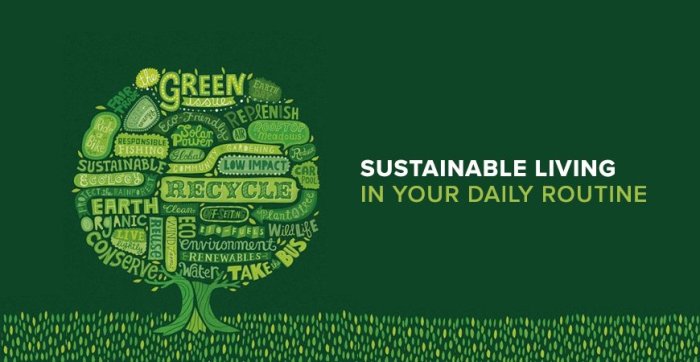Sustainable living is all about making conscious choices that benefit both the environment and our well-being. From energy sources to food choices and fashion practices, this lifestyle promotes long-term resource conservation and a healthier planet. Get ready to dive into the world of sustainable living where every decision counts!
Benefits of Sustainable Living
Living sustainably offers numerous advantages for both the environment and personal well-being. By adopting sustainable practices in daily life, individuals can contribute to long-term resource conservation and make a positive impact on the world around them.
Environmental Impact
- Reduced carbon footprint: Choosing eco-friendly transportation options and energy-efficient appliances can help decrease greenhouse gas emissions, combating climate change.
- Preservation of natural habitats: By supporting sustainable agriculture and forestry practices, we can protect biodiversity and prevent deforestation.
- Waste reduction: Recycling, composting, and reducing single-use plastics can minimize landfill waste and pollution in our oceans and waterways.
Personal Well-being
- Improved health: Eating locally sourced, organic foods and engaging in outdoor activities can lead to better physical and mental well-being.
- Financial savings: Energy-efficient homes and sustainable transportation choices can lower utility bills and expenses, saving money in the long run.
- Stronger community connections: Participating in local sustainability initiatives and supporting eco-friendly businesses can foster a sense of belonging and purpose.
Resource Conservation
- Water preservation: Implementing water-saving fixtures and practices can help conserve this precious resource for future generations.
- Energy efficiency: Using renewable energy sources like solar power and reducing energy consumption can decrease reliance on finite fossil fuels.
- Promotion of circular economy: Embracing the principles of reduce, reuse, and recycle can create a more sustainable and efficient use of resources within our society.
Sustainable Energy Sources

When it comes to sustainable living, one of the key aspects is the use of renewable energy sources such as solar, wind, and hydroelectric power. These sources of energy are abundant, clean, and have minimal impact on the environment compared to traditional fossil fuels.
Solar Energy
Solar energy is harnessed from the sun’s rays using solar panels, which convert sunlight into electricity. This renewable energy source is sustainable, abundant, and can be used to power homes, businesses, and even entire communities. By utilizing solar energy, we reduce our dependence on fossil fuels and decrease harmful greenhouse gas emissions.
Wind Energy
Wind energy is generated by harnessing the power of wind turbines to produce electricity. This clean energy source is highly efficient and has minimal impact on the environment. By investing in wind energy, we can reduce air pollution, combat climate change, and create a more sustainable future for generations to come.
Hydroelectric Power
Hydroelectric power is generated by capturing the energy from flowing water in rivers and dams. This renewable energy source is reliable, cost-effective, and produces electricity without emitting harmful pollutants. By transitioning to hydroelectric power, we can reduce our carbon footprint and preserve natural ecosystems.
Sustainable Food Choices: Sustainable Living
Eating sustainably goes beyond just the types of food we consume; it also includes where our food comes from and how it is produced. Making conscious choices about our food can have a significant impact on the environment and our overall well-being.
Importance of Organic, Locally Sourced, and Seasonal Foods
Organic foods are grown without synthetic pesticides or fertilizers, which helps reduce harm to the environment and our bodies. Locally sourced foods support local farmers, reduce transportation emissions, and ensure freshness. Seasonal foods are more nutritious, flavorful, and require fewer resources to grow.
Tips for Reducing Food Waste and Adopting a Plant-Based Diet
- Avoid buying more food than you need and utilize leftovers creatively to minimize waste.
- Embrace a plant-based diet by incorporating more fruits, vegetables, legumes, and whole grains into your meals.
- Consider starting with “Meatless Mondays” to gradually reduce your meat consumption and explore plant-based alternatives.
Community-Supported Agriculture and Farmers’ Markets
Community-supported agriculture (CSA) allows consumers to purchase seasonal produce directly from local farmers, fostering a closer connection to where our food comes from. Farmers’ markets offer a variety of fresh, locally grown products while supporting small-scale agriculture and reducing the carbon footprint of food transportation.
Sustainable Fashion Practices

Sustainable fashion practices play a crucial role in promoting eco-conscious living by focusing on ethical production and consumption of clothing items.
Slow Fashion and its Role
Slow fashion emphasizes quality over quantity, encouraging consumers to invest in timeless pieces that are made to last. By supporting slow fashion brands, individuals can reduce waste and contribute to a more sustainable fashion industry.
Environmental Impact of Fast Fashion
Fast fashion, characterized by rapid production cycles and low-cost garments, results in significant environmental damage due to overconsumption, textile waste, and harmful manufacturing processes. Embracing ethical clothing production helps minimize these negative impacts on the environment.
Benefits of Ethical Clothing Production, Sustainable living
Ethical clothing production promotes fair labor practices, reduces carbon footprint, and supports sustainable materials sourcing. By choosing ethically-made clothing items, individuals can positively impact both the environment and garment workers’ well-being.
Tips for Creating a Sustainable Wardrobe
- Upcycling: Give new life to old clothing items by repurposing them into unique pieces.
- Thrifting: Explore second-hand stores or online platforms to find pre-loved garments and reduce textile waste.
- Support Eco-friendly Brands: Choose clothing brands that prioritize sustainability, transparency, and ethical practices in their production processes.